Effect of Natural Aging on Cold Forming Performance of 2219 Aluminum Alloy
Abstract
1. Introduction
2. Experimental Section
2.1. Materials
2.2. Solution Treatment and Natural Aging
2.3. Material Tests
3. Results and Discussion
3.1. Analysis of Deformation Behavior
3.2. Evolution of Mechanical Properties
3.3. Analysis of Microstructures
4. Conclusions
- (1)
- The Portevin–Le Chatelier (PLC) effect of 2219 aluminum alloy weakens gradually as the natural aging time increases. The stress drop amplitude of the stress–strain curves is around 7–10 MPa for aging times below 10 days but drops to only about 1 MPa after 2 years of aging. Thus, with an aging time of 2 years, the PLC effect becomes indistinct, indicating that long-term aging can reduce the influence of the PLC effect on the forming process of 2219 aluminum alloy and is favorable for the improvement of cold forming performance.
- (2)
- The yield strength of 2219 aluminum alloy increases rapidly when the natural aging time is less than 4 days, and then the rate of increase gradually decreases. After aging for 2 years, the yield strength of 2219 aluminum alloy increased by 28.6% compared to that of the newly quenched state. However, the elongation first increases rapidly and then decreases, and the maximum elongation occurs at an aging time of approximately 4 days.
- (3)
- The strain hardening index of the 2219 aluminum alloy decreases steadily as the aging time surpasses 4 days. The evolution of strain hardening index shows that short-term natural aging (less than 4 days) increases the work hardening rate of the alloy, while long-term natural aging can reduce the work hardening rate and facilitate stable forming.
- (4)
- The strengthening effect of natural aging on 2219 aluminum alloy is mainly due to the growth of G.P. zones and the precipitation of θ″ phases. The precipitation behavior during natural aging process can also cause the aggregation of solute atoms and weaken the PLC effect.
Author Contributions
Funding
Institutional Review Board Statement
Informed Consent Statement
Data Availability Statement
Acknowledgments
Conflicts of Interest
Abbreviations
| DSC | Differential scanning calorimetry |
| F–Q–A | Forming–quenching–aging |
| NA | Natural aging |
| HRTEM | High-resolution transmission electron microscopy |
| PLC | Portevin–Le Chatelier |
| Q–F–A | Quenching–forming–aging |
| SAD | Selected Area Diffraction |
| TEM | Transmission electron microscopy |
References
- Surekha, K.; Murty, B.; Rao, K.P. Microstructural characterization and corrosion behavior of multipass friction stir processed AA2219 aluminium alloy. Surf. Coat. Technol. 2008, 202, 4057–4068. [Google Scholar] [CrossRef]
- Dursun, T.; Soutis, C. Recent developments in advanced aircraft aluminium alloys. Mater. Des. 2014, 56, 862–871. [Google Scholar] [CrossRef]
- Wang, H.; He, D.; Liao, M.; Liu, P.; Lai, R. Study on Quality Prediction of 2219 Aluminum Alloy Friction Stir Welding Based on Real-Time Temperature Signal. Materials 2021, 14, 3496. [Google Scholar] [CrossRef] [PubMed]
- Music, O.; Allwood, J.; Kawai, K.-I. A review of the mechanics of metal spinning. J. Mater. Process. Technol. 2010, 210, 3–23. [Google Scholar] [CrossRef]
- Nallathambi, A.K.; Kaymak, Y.; Specht, E.; Bertram, A. Distortion and residual stresses during metal quenching process. In Micro-Macro-Interactions in Structured Media and Particle Systems; Bertram, A., Thomas, J., Eds.; Springer: Berlin/Heidelberg, Germany, 2008; pp. 145–157. [Google Scholar] [CrossRef]
- Khan, S.; Hussain, G.; Ilyas, M.; Rashid, H.; Khan, M.I.; Khan, W.A. Appropriate heat treatment and incremental forming route to produce age-hardened components of Al-2219 alloy with minimized form error and high formability. J. Mater. Process. Technol. 2018, 256, 262–273. [Google Scholar] [CrossRef]
- Li, Z.; Zhan, M.; Fan, X.; Wang, X.; Ma, F. Age hardening behaviors of spun 2219 aluminum alloy component. J. Mater. Res. Technol. 2020, 9, 4706–4716. [Google Scholar] [CrossRef]
- Li, Z.X.; Zhan, M.; Fan, X.G.; Ma, F.; Wang, J.W. Constitutive Model Over Wide Temperature Range and Considering Negative-to-Positive Strain Rate Sensitivity for As-Quenched AA2219 Sheet. J. Mater. Eng. Perform. 2019, 28, 404–413. [Google Scholar] [CrossRef]
- Lee, S.-Y.; Takushima, C.; Hamada, J.-I.; Nakada, N. Macroscopic and microscopic characterizations of Portevin-LeChatelier effect in austenitic stainless steel using high-temperature digital image correlation analysis. Acta Mater. 2021, 205, 116560. [Google Scholar] [CrossRef]
- Hopperstad, O.S.; Børvik, T.; Berstad, T.; Lademo, O.-G.; Benallal, A. A numerical study on the influence of the Portevin–Le Chatelier effect on necking in an aluminium alloy. Model. Simul. Mater. Sci. Eng. 2007, 15, 747–772. [Google Scholar] [CrossRef]
- Koehler, J.S.; Cottrell, A.H. Dislocations and Plastic Flow in Crystals; Oxford University Press: New York, NY, USA, 1953; pp. 223–228. [Google Scholar] [CrossRef]
- Robinson, J.M.; Shaw, M.P. Microstructural and mechanical influences on dynamic strain aging phenomena. Int. Mater. Rev. 1994, 39, 113–122. [Google Scholar] [CrossRef]
- Sheikh, H. Investigation into Characteristics of Portevin-Le Chatelier Effect of an Al-Mg Alloy. J. Mater. Eng. Perform. 2010, 19, 1264–1267. [Google Scholar] [CrossRef]
- Cottrell, A.H.; Bilby, B.A. Dislocation Theory of Yielding and Strain Ageing of Iron. Proc. Phys. Soc. Sect. A 1949, 62, 49–62. [Google Scholar] [CrossRef]
- Curtin, W.A.; Olmsted, D.L.; Hector, L.G. A predictive mechanism for dynamic strain ageing in aluminium–magnesium alloys. Nat. Mater. 2006, 5, 875–880. [Google Scholar] [CrossRef]
- Yang, Z.; Banhart, J. Natural and artificial ageing in aluminium alloys—The role of excess vacancies. Acta Mater. 2021, 215, 117014. [Google Scholar] [CrossRef]
- Wu, S.; Chien, C.; Yang, C.; Bor, H. The Portevin–Le Chatelier effect in β-phase Mg–14.3Li–0.8Zn alloy. Mater. Sci. Eng. A 2014, 605, 33–38. [Google Scholar] [CrossRef]
- Wang, W.-H.; Wu, D.; Chen, R.-S.; Lou, C.-S. Influence of temperature and strain rate on serration type transition in NZ31 Mg alloy. Trans. Nonferrous Met. Soc. China 2015, 25, 3611–3617. [Google Scholar] [CrossRef]
- Wang, W.; Wu, D.; Chen, R.; Zhang, X. Effect of solute atom concentration and precipitates on serrated flow in Mg-3Nd-Zn alloy. J. Mater. Sci. Technol. 2019, 34, 1236–1242. [Google Scholar] [CrossRef]
- Li, X.; Zhang, J.; Akiyama, E.; Fu, Q.; Li, Q. Hydrogen embrittlement behavior of Inconel 718 alloy at room temperature. J. Mater. Sci. Technol. 2018, 35, 499–502. [Google Scholar] [CrossRef]
- Hu, Q.; Zhang, Q.C.; Fu, S.H.; Gong, M. Influence of precipitation on the Portevin-Le Chatelier effect in Al-Mg alloys. Theor. Appl. Mech. Lett. 2011, 1, 34–37. [Google Scholar] [CrossRef]
- Li, H.; Park, J. The serrated flow behavior of a binary Al-Li alloy tempered to conditions with and without δ′ precipitates. Mater. Sci. Eng. A 2000, 280, 156–160. [Google Scholar] [CrossRef]
- Pu, E.; Zheng, W.; Song, Z.; Zhang, K.; Liu, S.; Shen, W.; Dong, H. The effect of aging on the serrated yielding and intermediate temperature embrittlement of nickel-base C-276 alloy. Mater. Sci. Eng. A 2017, 714, 59–67. [Google Scholar] [CrossRef]
- Markus, H.; Ismail, C.; Philipp, F.; Martin, W. On the PLC effect in a particle reinforced AA2017 alloy. Met.-Open Access Metall. J. 2018, 8, 88. [Google Scholar] [CrossRef]
- Choi, Y.; Ha, J.; Lee, M.-G.; Korkolis, Y.P. Effect of plastic anisotropy and Portevin-Le Chatelier bands on hole-expansion in AA7075 sheets in -T6 and -W tempers. J. Mater. Process. Technol. 2021, 296, 117211. [Google Scholar] [CrossRef]
- Zheng, G.; Li, H.; Lei, C.; Fu, J.; Bian, T.; Yang, J. Natural aging behaviors and mechanisms of 7050 and 5A90 Al alloys: A comparative study. Mater. Sci. Eng. A 2018, 718, 157–164. [Google Scholar] [CrossRef]
- Ivanov, R.; Deschamps, A.; De Geuser, F. Clustering kinetics during natural ageing of Al-Cu based alloys with (Mg, Li) additions. Acta Mater. 2018, 157, 186–195. [Google Scholar] [CrossRef]
- Wu, C.; Li, H.; Bian, T.; Lei, C.; Zhang, L. Natural aging behaviors of Al-Cu-Li alloy: PLC effect, properties and microstructure evolution. Mater. Charact. 2022, 184, 111694. [Google Scholar] [CrossRef]
- Davis, J.R. ASM International Alloy Handbook Committee. In Properties and Selection: Nonferrous Alloys and Special-Purpose Materials, 2nd ed.; ASM International: Materials Park, OH, USA, 1990. [Google Scholar]
- Chandler, H. Heat Treater’s Guide—Practices and Procedures for Nonferrous Alloys; ASM International: Materials Park, OH, USA, 1996; pp. 165–167. [Google Scholar]
- Papazian, J.M. Calorimetric Studies of Precipitation and Dissolution Kinetics in Aluminum Alloys 2219 and 7075. Met. Mater. Trans. A 1982, 13, 761–769. [Google Scholar] [CrossRef]
- Papazian, J.M. A calorimetric study of precipitation in aluminum alloy 2219. Met. Mater. Trans. A 1981, 12, 269–280. [Google Scholar] [CrossRef]
- Wang, H.; Yi, Y.; Huang, S. Microstructure Evolution and Mechanical Properties of 2219 Al Alloy During Aging Treatment. J. Mater. Eng. Perform. 2017, 26, 1475–1482. [Google Scholar] [CrossRef]
- Zhang, W.; He, H.; Yi, Y.; Huang, S. Influence of thermomechanical processing on coarse particles, grain structure, and mechanical properties of Al–Cu alloy rings. J. Mater. Res. Technol. 2023, 22, 1136–1150. [Google Scholar] [CrossRef]
- Li, H.; Guo, X.; Wang, W.; Sun, Z.; Liu, H.; Zheng, X.; Tao, J. Forming performance of an as-quenched novel aluminum-lithium alloy. Int. J. Adv. Manuf. Technol. 2014, 78, 659–666. [Google Scholar] [CrossRef]
- Bian, X.; Yuan, F.; Wu, X. Correlation between strain rate sensitivity and characteristics of Portevin-LeChátelier bands in a twinning-induced plasticity steel. Mater. Sci. Eng. A 2017, 696, 220–227. [Google Scholar] [CrossRef]
- Kar, A.; Ghosh, M.; Ray, A.K.; Ray, A.K. Effect of interfacial thickness and residual stress on the mechanical property of the alumina–stainless steel braze joint interface. Mater. Sci. Eng. A 2008, 498, 283–288. [Google Scholar] [CrossRef]
- Hertelé, S.; De Waele, W.; Denys, R. A generic stress–strain model for metallic materials with two-stage strain hardening behaviour. Int. J. Non-Linear Mech. 2011, 46, 519–531. [Google Scholar] [CrossRef]
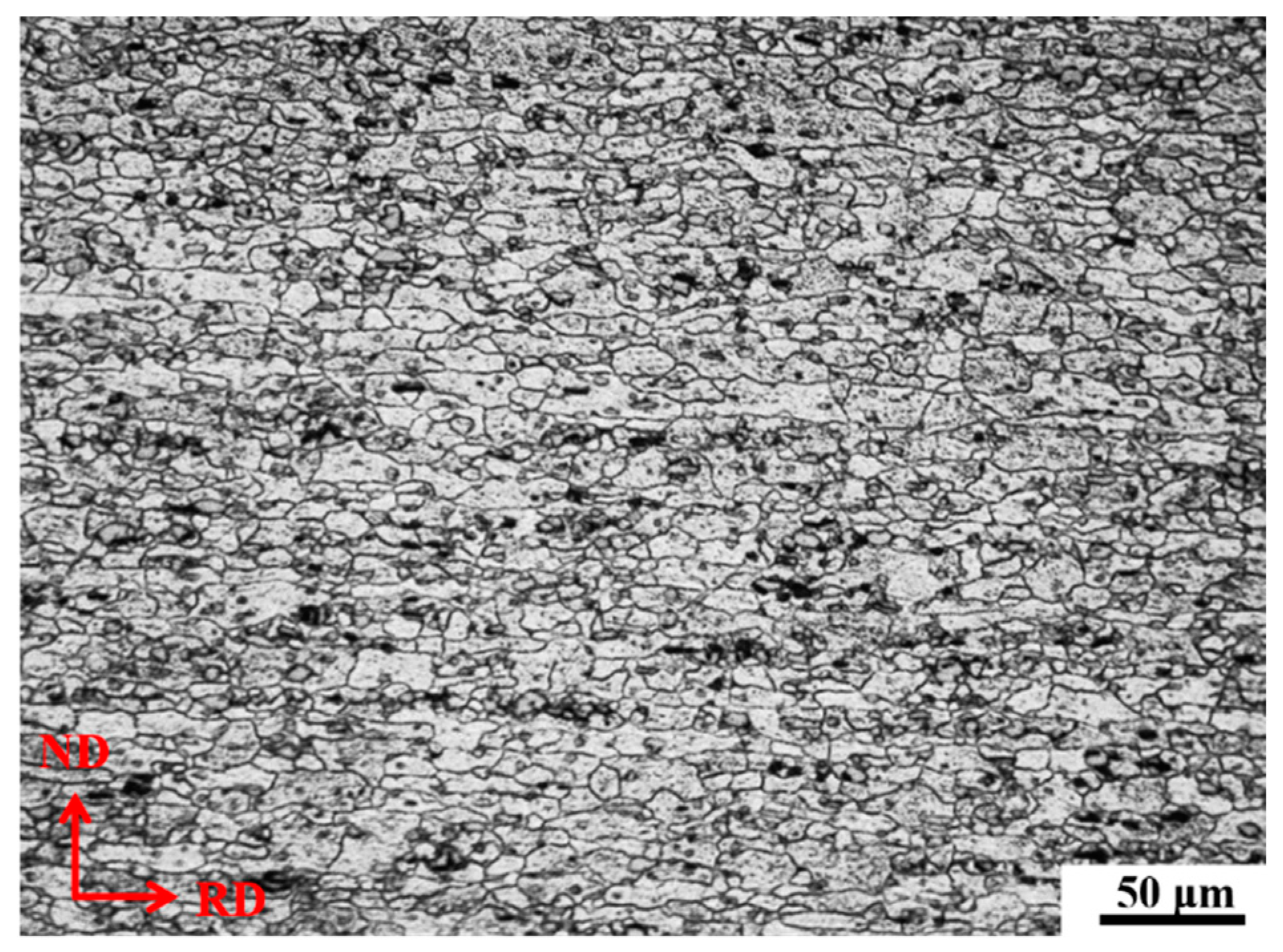

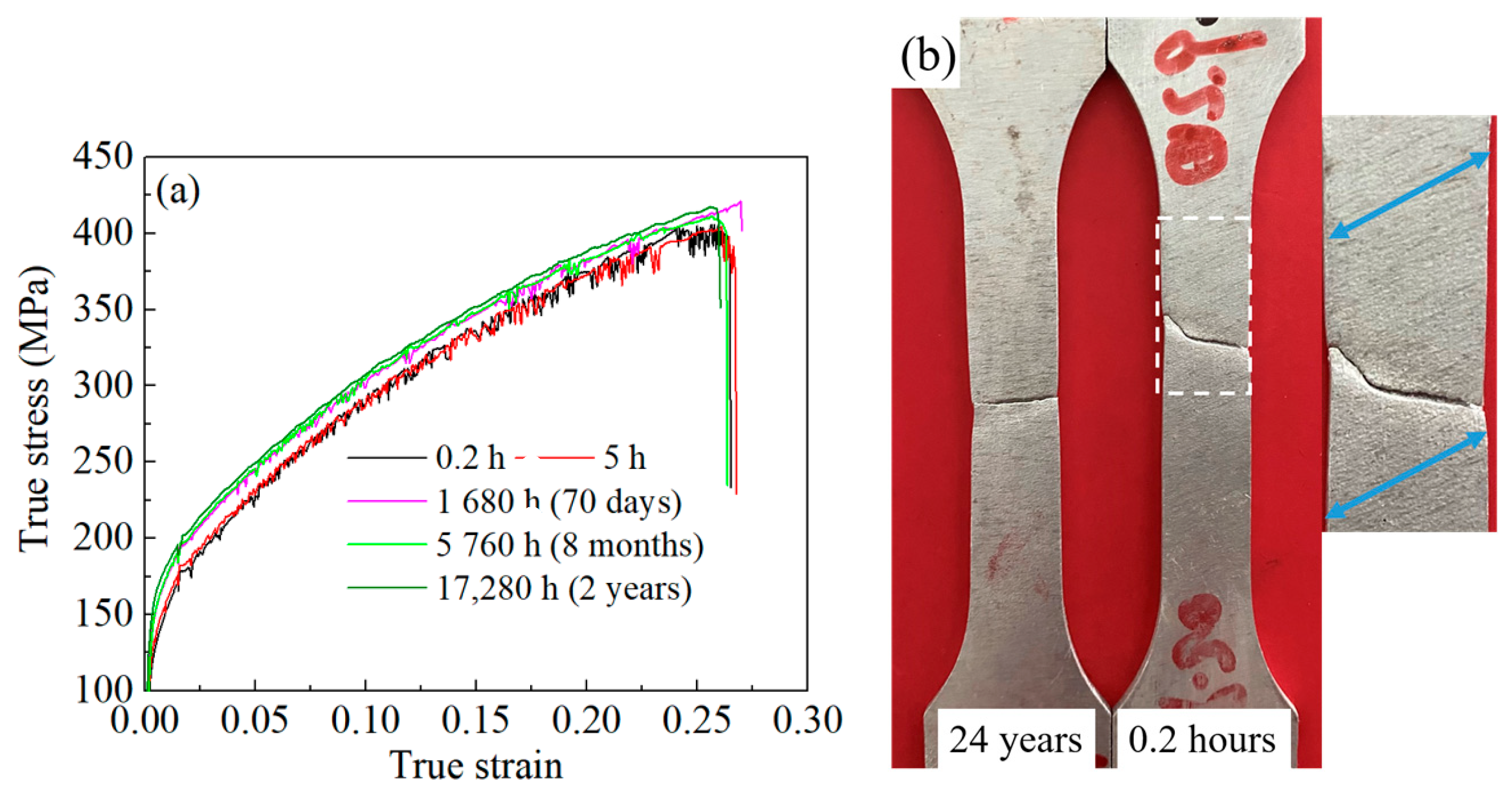
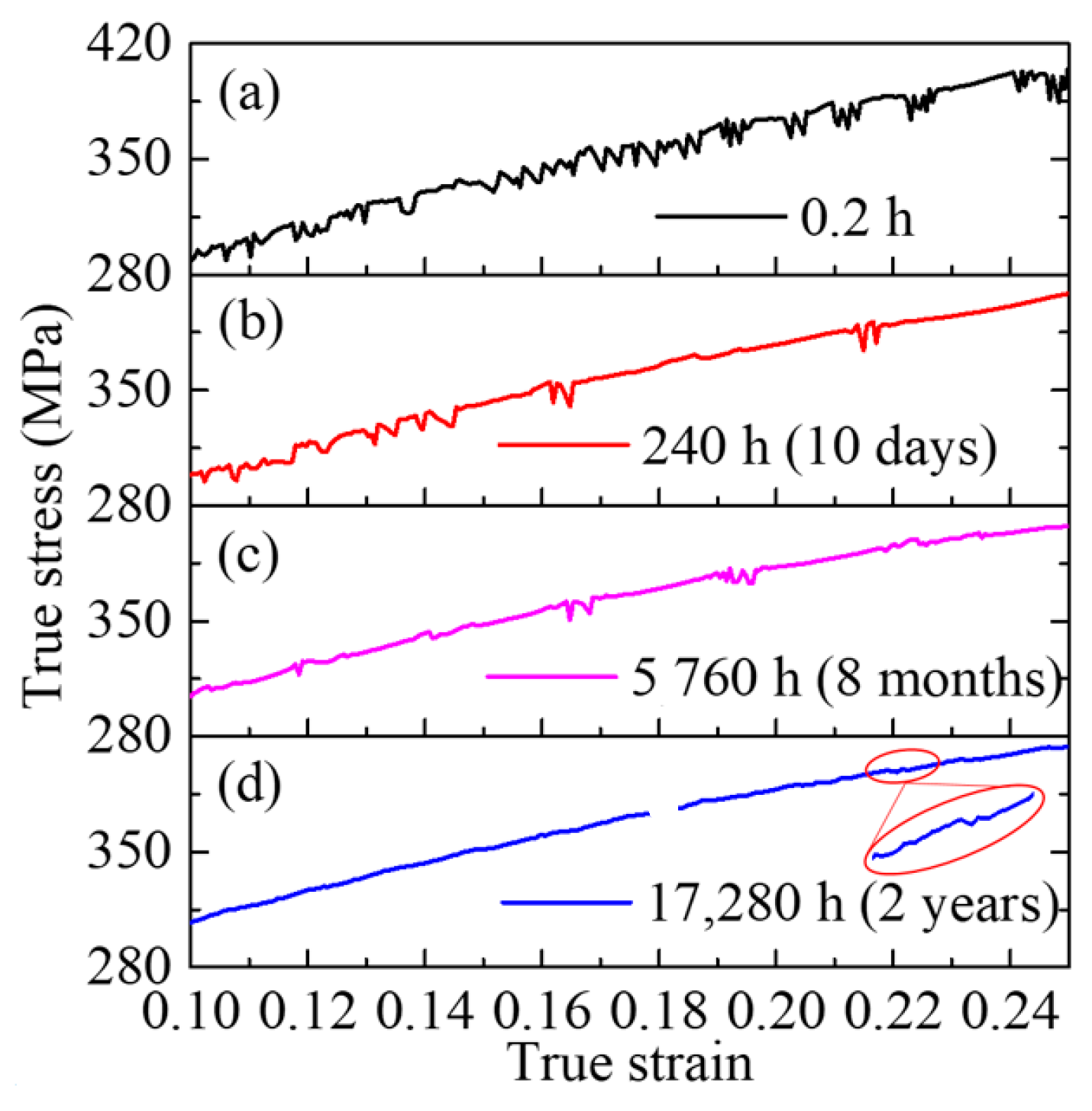
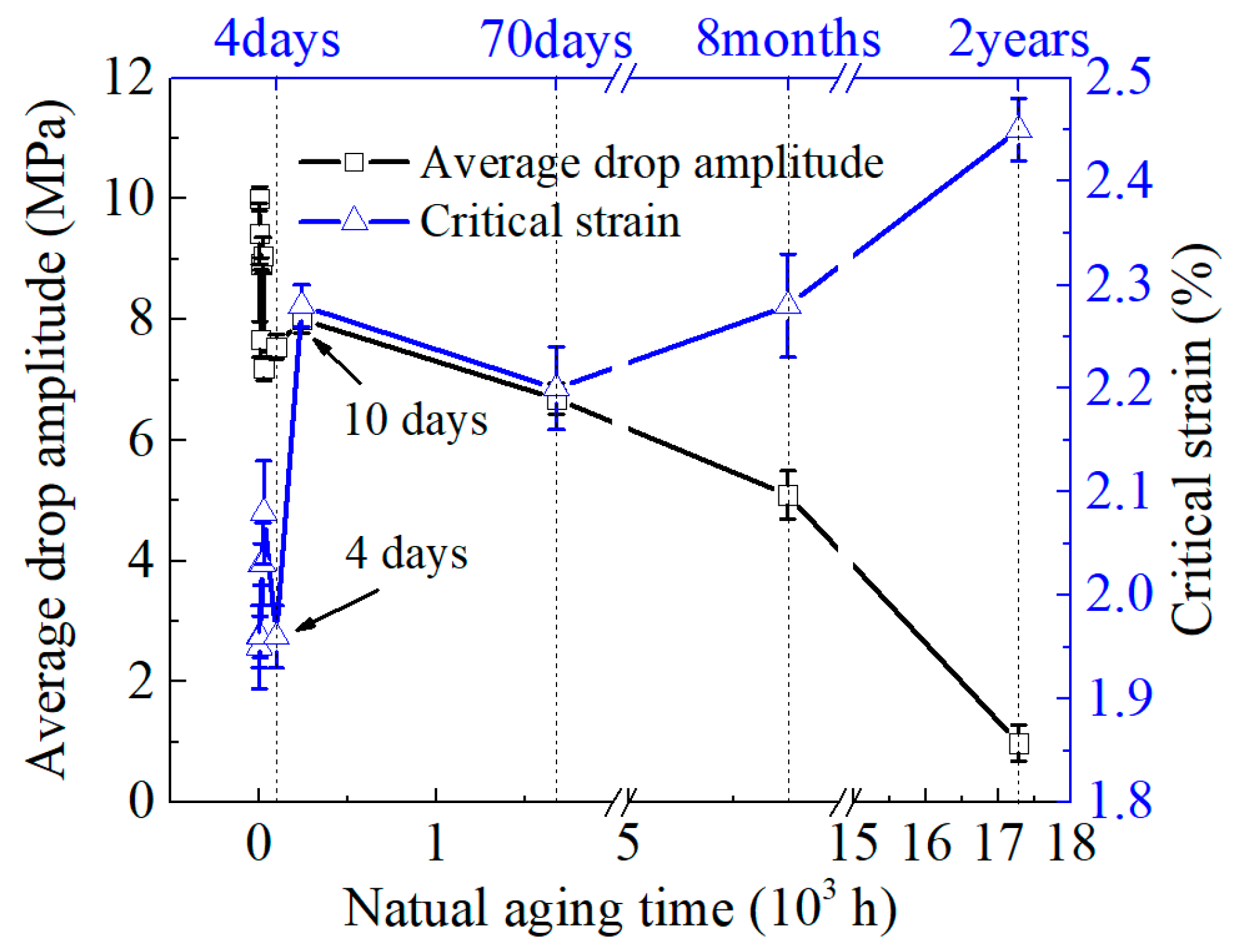

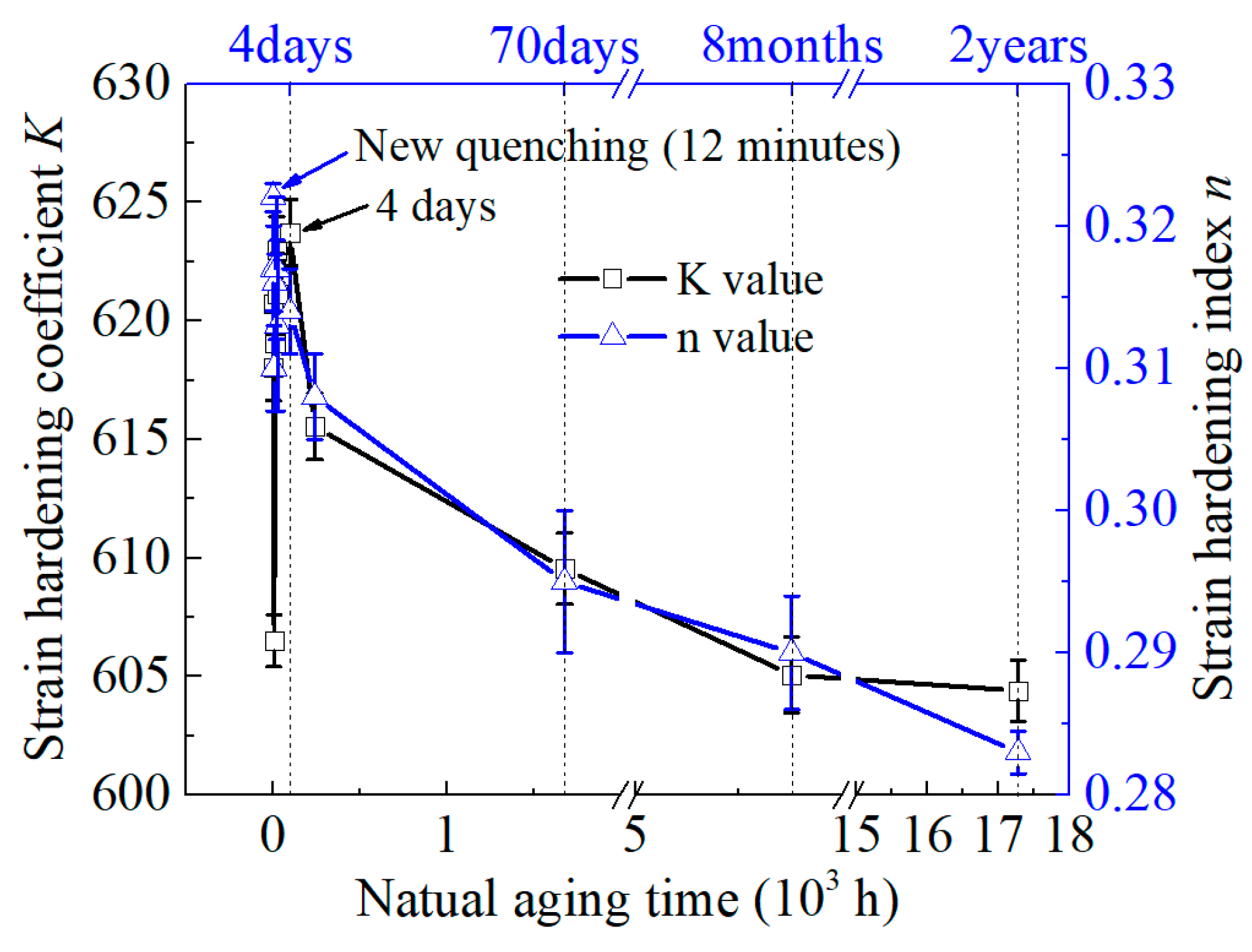
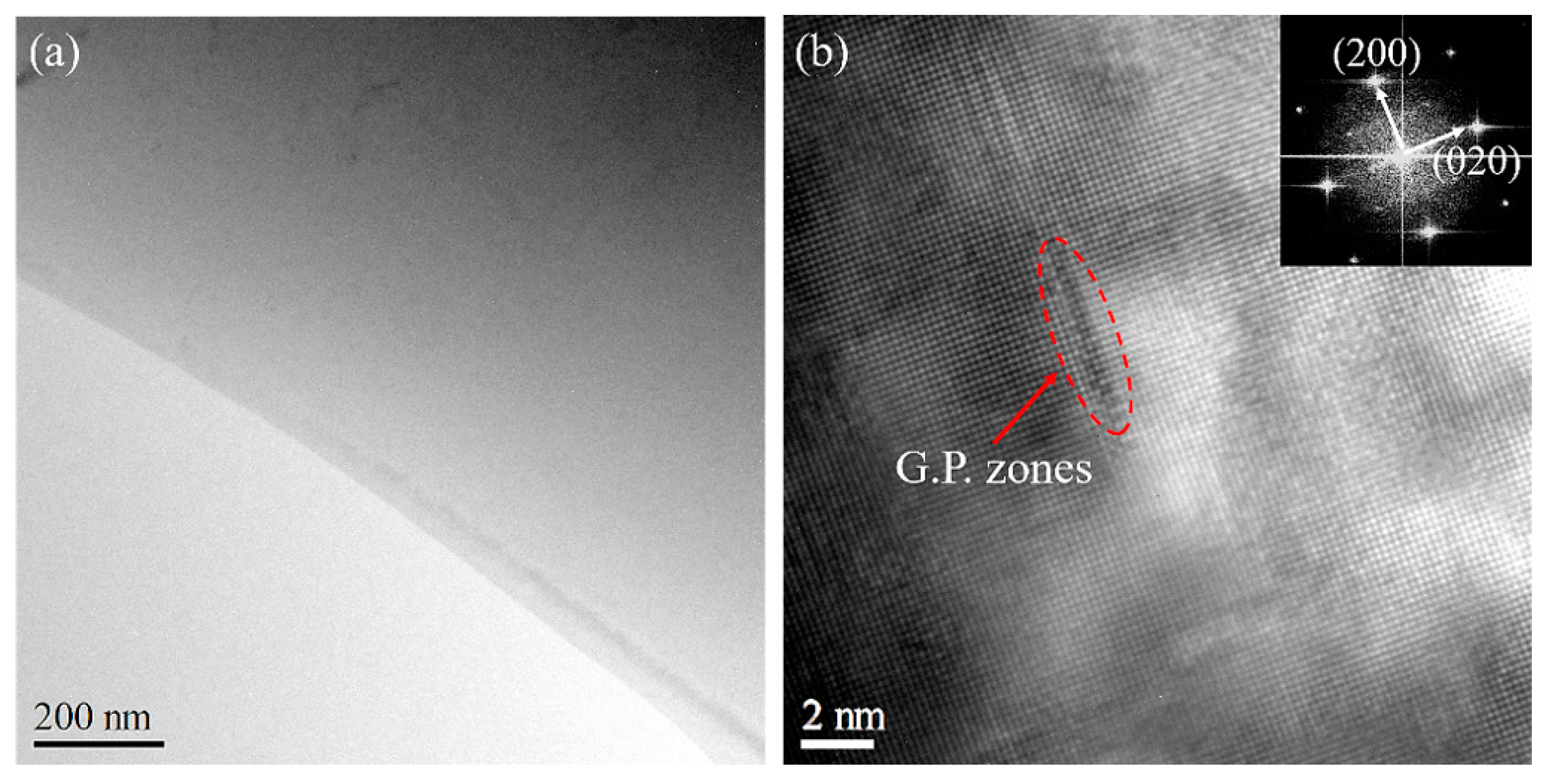
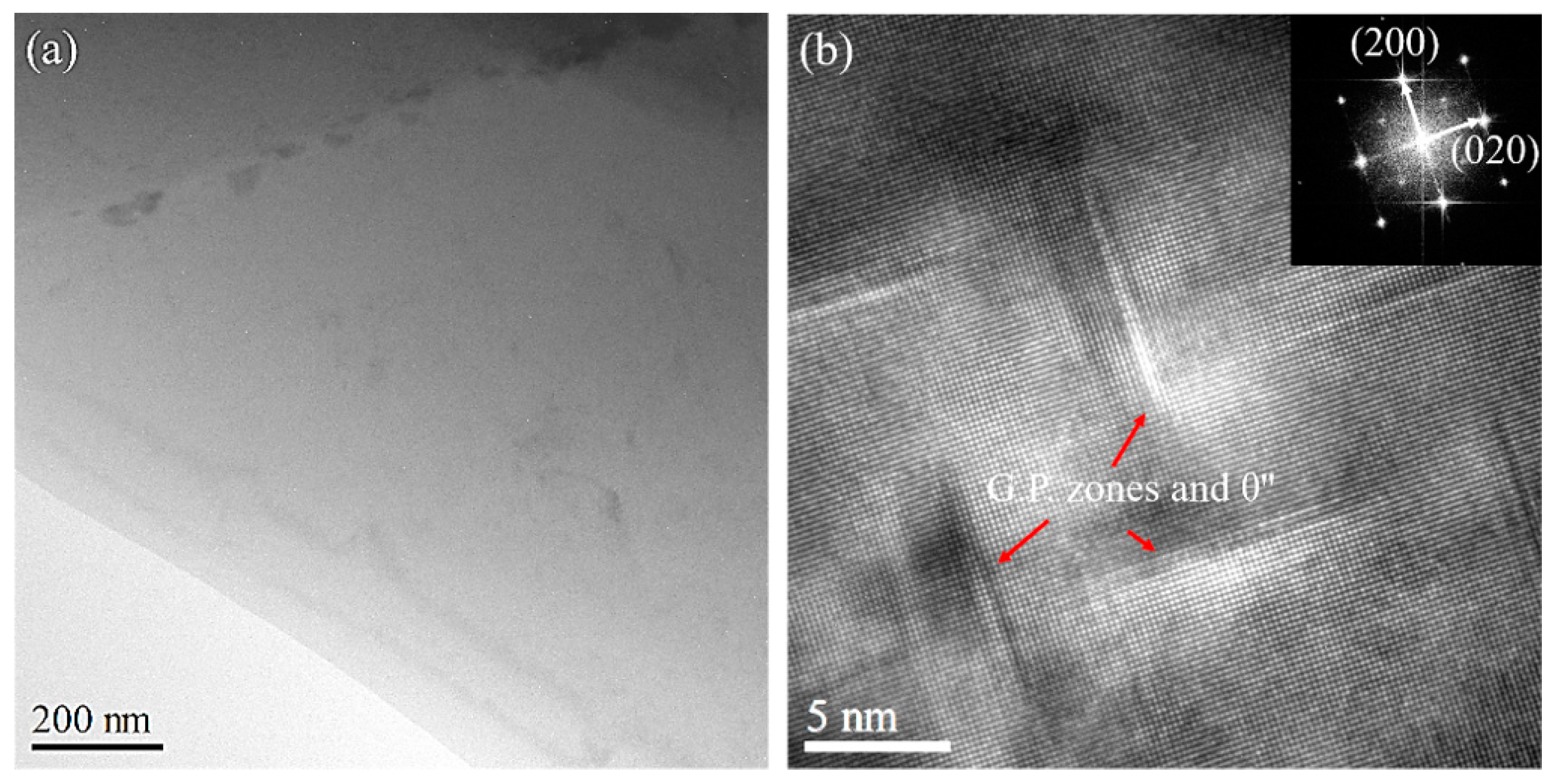
| Element | Cu | Mn | Fe | Zr | Ti | Si | Zn | Mg | Al |
|---|---|---|---|---|---|---|---|---|---|
| wt% | 6.5 | 0.36 | 0.21 | 0.18 | 0.06 | 0.05 | 0.02 | 0.01 | Remainder |
Disclaimer/Publisher’s Note: The statements, opinions and data contained in all publications are solely those of the individual author(s) and contributor(s) and not of MDPI and/or the editor(s). MDPI and/or the editor(s) disclaim responsibility for any injury to people or property resulting from any ideas, methods, instructions or products referred to in the content. |
© 2023 by the authors. Licensee MDPI, Basel, Switzerland. This article is an open access article distributed under the terms and conditions of the Creative Commons Attribution (CC BY) license (https://creativecommons.org/licenses/by/4.0/).
Share and Cite
Li, Z.-X.; Shi, Y.-L.; Xu, L.-P.; Jin, J.-X. Effect of Natural Aging on Cold Forming Performance of 2219 Aluminum Alloy. Materials 2023, 16, 3536. https://doi.org/10.3390/ma16093536
Li Z-X, Shi Y-L, Xu L-P, Jin J-X. Effect of Natural Aging on Cold Forming Performance of 2219 Aluminum Alloy. Materials. 2023; 16(9):3536. https://doi.org/10.3390/ma16093536
Chicago/Turabian StyleLi, Zhi-Xin, Yi-Long Shi, Luo-Peng Xu, and Jia-Xin Jin. 2023. "Effect of Natural Aging on Cold Forming Performance of 2219 Aluminum Alloy" Materials 16, no. 9: 3536. https://doi.org/10.3390/ma16093536
APA StyleLi, Z.-X., Shi, Y.-L., Xu, L.-P., & Jin, J.-X. (2023). Effect of Natural Aging on Cold Forming Performance of 2219 Aluminum Alloy. Materials, 16(9), 3536. https://doi.org/10.3390/ma16093536





